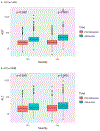Abnormal Liver Tests in COVID-19: A Retrospective Observational Cohort Study of 1,827 Patients in a Major U.S. Hospital Network
- PMID: 32725890
- PMCID: PMC9258788
- DOI: 10.1002/hep.31487
Abnormal Liver Tests in COVID-19: A Retrospective Observational Cohort Study of 1,827 Patients in a Major U.S. Hospital Network
Abstract
Background and aims: The coronavirus-19 disease (COVID-19) pandemic, caused by the severe acute respiratory syndrome coronavirus 2 virus, is associated with significant morbidity and mortality attributable to pneumonia, acute respiratory distress syndrome, and multiorgan failure. Liver injury has been reported as a nonpulmonary manifestation of COVID-19, but characterization of liver test abnormalities and their association with clinical outcomes is incomplete.
Approach and results: We conducted a retrospective cohort study of 1,827 patients with confirmed COVID-19 who were hospitalized within the Yale-New Haven Health System between March 14, 2020 and April 23, 2020. Clinical characteristics, liver tests (aspartate aminotransferase [AST], alanine aminotransferase [ALT], alkaline phosphatase [ALP], total bilirubin [TBIL], and albumin) at three time points (preinfection baseline, admission, and peak hospitalization), and hospitalization outcomes (severe COVID-19, intensive care unit [ICU] admission, mechanical ventilation, and death) were analyzed. Abnormal liver tests were commonly observed in hospitalized patients with COVID-19, both at admission (AST 66.9%, ALT 41.6%, ALP 13.5%, and TBIL 4.3%) and peak hospitalization (AST 83.4%, ALT 61.6%, ALP 22.7%, and TBIL 16.1%). Most patients with abnormal liver tests at admission had minimal elevations 1-2× the upper limit of normal (ULN; AST 63.7%, ALT 63.5%, ALP 80.0%, and TBIL 75.7%). A significant proportion of these patients had abnormal liver tests prehospitalization (AST 25.9%, ALT 38.0%, ALP 56.8%, and TBIL 44.4%). Multivariate analysis revealed an association between abnormal liver tests and severe COVID-19, including ICU admission, mechanical ventilation, and death; associations with age, male sex, body mass index, and diabetes mellitus were also observed. Medications used in COVID-19 treatment (lopinavir/ritonavir, hydroxychloroquine, remdesivir, and tocilizumab) were associated with peak hospitalization liver transaminase elevations >5× ULN.
Conclusions: Abnormal liver tests occur in most hospitalized patients with COVID-19 and may be associated with poorer clinical outcomes.
© 2020 by the American Association for the Study of Liver Diseases.
Conflict of interest statement
Figures



Comment in
-
Letter to the Editor: Serum Albumin in COVID-19: A Good Example in Which Analytical and Clinical Performance of a Laboratory Test Are Strictly Intertwined.Hepatology. 2021 Nov;74(5):2905-2907. doi: 10.1002/hep.31791. Epub 2021 Sep 16. Hepatology. 2021. PMID: 33665867 Free PMC article. No abstract available.
References
-
- Wu Z, McGoogan JM. Characteristics of and Important Lessons from the Coronavirus Disease 2019 (COVID-19) Outbreak in China: Summary of a Report of 72 314 Cases from the Chinese Center for Disease Control and Prevention. JAMA. 2020;323(13): 1239–1242. - PubMed
-
- WHO COVID timeline. Weblink: https://www.who.int/news-room/detail/27-04-2020-who-timeline---covid-19. Accessed May 12, 2020.
-
- Rodriguez-Morales AJ, Cardona-Ospina JA, Gutierrez-Ocampo E, Villamizar-Pena R, Holguin-Rivera Y, Escalera-Antezana JP et al. Clinical and laboratory and imaging features of COVID-19: a systematic review and meta-analysis. Travel Med Inf Dis. 2020. Mar 13 [Epub ahead of print] doi: 10.1016/j.tmaid.2020.101623. - DOI - PMC - PubMed
Publication types
MeSH terms
Grants and funding
LinkOut - more resources
Full Text Sources
Medical
Miscellaneous

